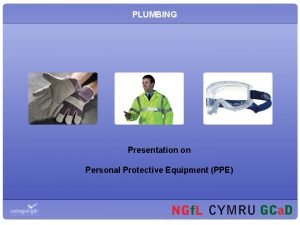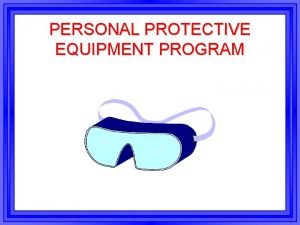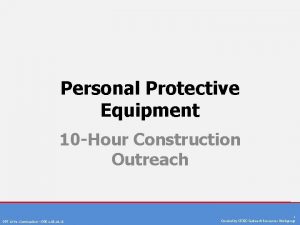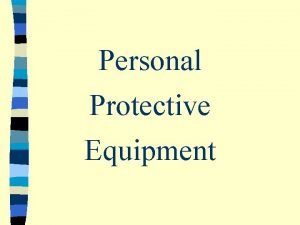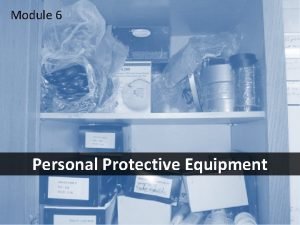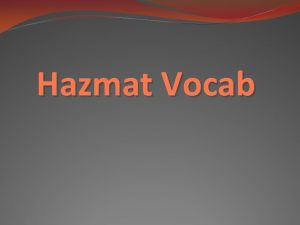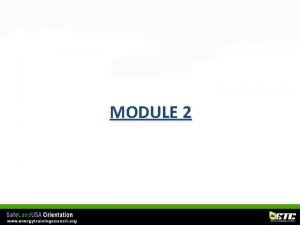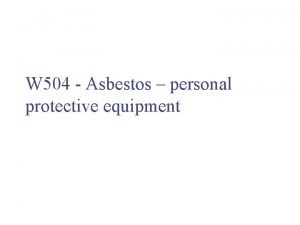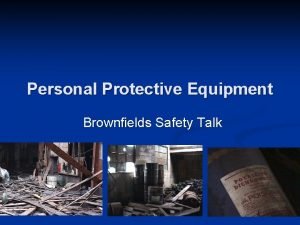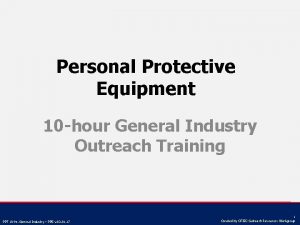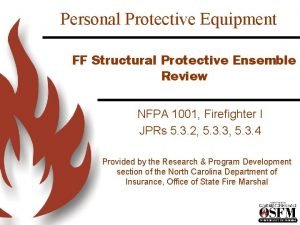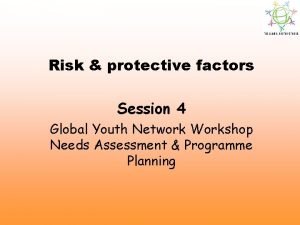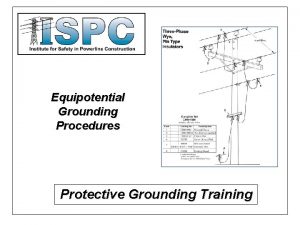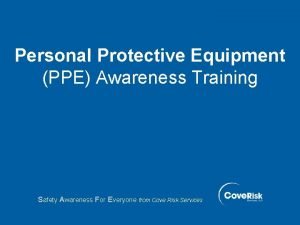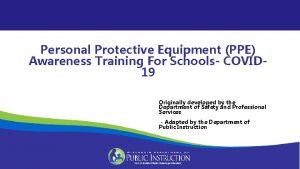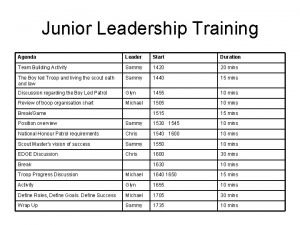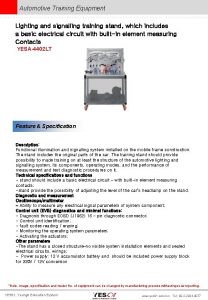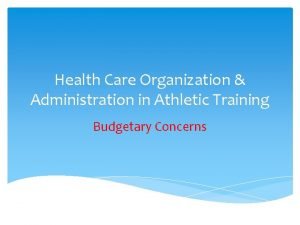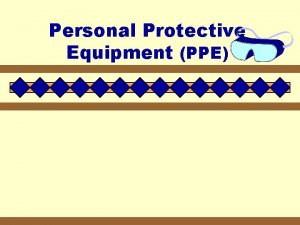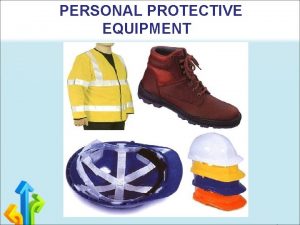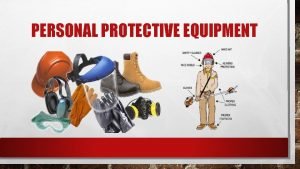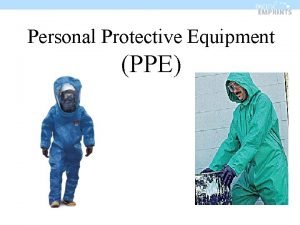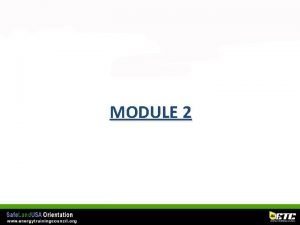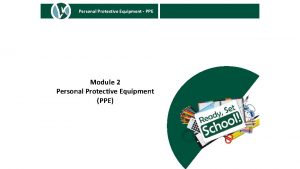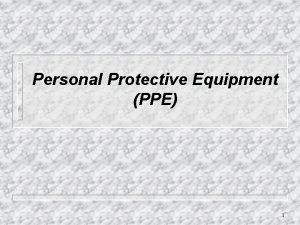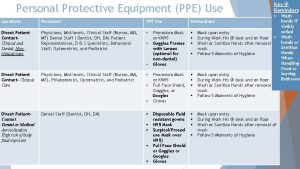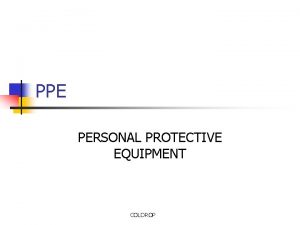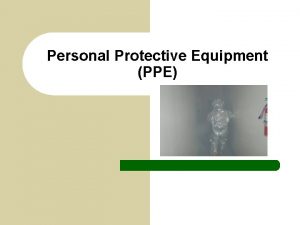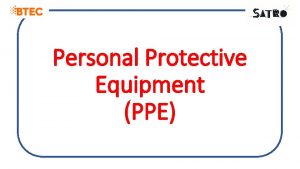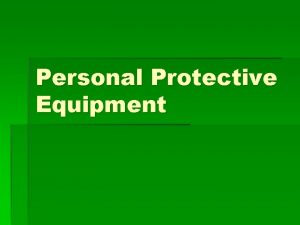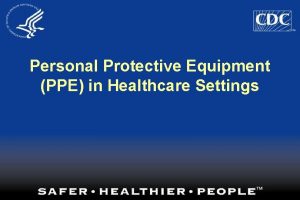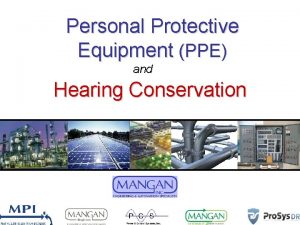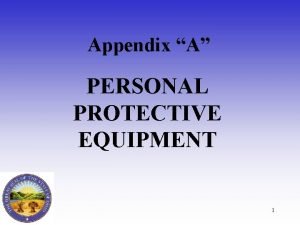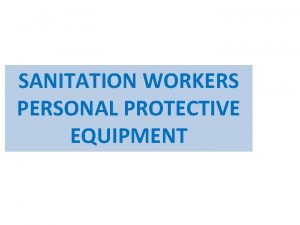PERSONAL PROTECTIVE EQUIPMENT PPE TRAINING PART 2 Agenda






































- Slides: 38

PERSONAL PROTECTIVE EQUIPMENT (PPE) TRAINING PART 2

Agenda Importance of personal protective equipment (PPE) n Regulatory background n BGSU’s written PPE Program n When PPE is necessary n What PPE is necessary n How to wear and limitations of assigned PPE n

Importance of Personal Protective Equipment (PPE) When hazards can not be eliminated through engineering and /or administrative controls, PPE must be used to protect the eyes, face, head, feet, hands, arms, body, ears, and lungs. Preventable Injuries (BGSU History) n n – – – Chemical burns to the eyes Chemical irritation to the eyes and skin Particulate matter in the eye Heat burns Slips, trips, and falls Cuts and abrasions

Importance of Personal Protective Equipment (PPE) What is PPE? Equipment that workers wear to protect themselves from hazards in their work environment. Examples: hearing protection safety goggles respirators safety glasses hard hats safety shoes gloves

Regulatory Background Occupational Safety and Health Act of 1970 n Occupational Safety and Health Administration (OSHA) n Public Employees Risk Reduction Act of 1994 n Public Employees Risk Reduction Program (PERRP) n 29 CFR 1910 Subpart I n

BGSU’s Written PPE Program Introduction Tab 1 Policy Statement n Forward n Objective n Applicability n

BGSU’s Written PPE Program Introduction n Responsibilities – – Occupational Safety and Health Specialist Management (Department Chairpersons and Directors) Supervisors Employees

BGSU’s Written PPE Program Introduction n Occupational Safety and Health Specialist Responsibilities – – coordinating the PPE Program; assisting departments with hazard assessments, analysis of injury / illness data, selection of PPE and training; considering and assisting in the implementation of engineering controls for recognized hazards and; maintaining copies of hazard assessments, reassessments, and PPE selection documentation.

BGSU’s Written PPE Program Introduction n Management Responsibilities – – supplying PPE to employees at no cost and; providing employees with adequate training.

BGSU’s Written PPE Program Introduction n Supervisor Responsibilities – – attending the PPE 1 training session offered by Environmental Health and Safety; performing hazard assessments and reassessments; fitting employees with PPE, issuing PPE, and providing the manufacturers instructions for use, care, limitations, and warnings; providing documentation to Environmental Health and Safety of hazard assessments and reassessments;

BGSU’s Written PPE Program Introduction n Supervisor Responsibilities (cont. ) – – ensuring all employees are trained on the PPE program and it’s requirements; maintaining records of hazard assessments, reassessments, training, retraining, and PPE selection; enforcing the PPE program by ensuring that all subordinates comply with all facets of BGSU’s PPE program, including inspection and maintenance and; providing a copy of the PPE Program to employees upon their request.

BGSU’s Written PPE Program Introduction n Employee Responsibilities – – attending the PPE 2 training session offered by Environmental Health and Safety; properly wearing, cleaning, maintaining, and inspecting all assigned PPE, according to the manufacturer’s instructions, and following the PPE program requirements; returning all damaged PPE to their immediate supervisor, to receive a replacement and; only using the PPE provided by the university.

BGSU’s Written PPE Program Introduction n Program Enforcement – A violation of a University employee’s responsibility must be reported to the employee’s immediate supervisor for appropriate action.

BGSU’s Written PPE Program Hazard Assessment The hazard assessment used to determine hazards in the workplace include: – – – Impact hazards Penetration hazards Compression hazards Chemical hazards Heat Harmful dust Optical radiation Biological hazards Noise hazards Electrical hazards Other

BGSU’s Written PPE Program Hazard Re-Assessment n n Supervisors must periodically reassess the workplace. Elements to consider in the reassessment include: ü Effectiveness of PPE Program ü Injury and illness experience ü Levels of exposure ü Adequacy of equipment selection ü Number of hour's workers wear various PPE ü Adequacy of training/fitting of PPE ü Program costs ü The adequacy of program records ü Coordination with overall safety and health program ü New equipment and/or processes

BGSU’s Written PPE Program Selection Guidelines n After completion of the hazard assessment, Environmental Health and Safety assists in the following procedures used for selection of personal protective equipment: – – – Reviews possible engineering and/or administrative controls before deciding to use PPE. Matches the potential hazards with the most appropriate types of PPE using the PPE Selection Guidelines found in Appendix B of BGSU’s written PPE Program. If, during the hazard assessment, a noise or respiratory hazard is indicated, the Occupational Safety and Health Specialist will provide additional program information and evaluation.

BGSU’s Written PPE Program Selection Guidelines Careful consideration must be given to comfort and fit. Departments must provide the user with proper, well-fitted protective devices. n Defective and damaged equipment or PPE shall not be used. n

BGSU’s Written PPE Program Training PPE 1 training session (Supervisor Session) n PPE 2 training session (This Session) n

BGSU’s Written PPE Program Training n Retraining is required, but not limited to, the following circumstances – – Changes in the workplace or changes in the types of PPE to be used which would render previous training obsolete or; Inadequacies in an employee's or supervisor’s knowledge in the use of the assigned PPE. When retraining occurs, a written certification that contains the name of each employee trained, the date, and the subject of the certification is required. Contact Environmental Health and Safety for questions or concerns.

BGSU’s Written PPE Program Cleaning and Maintenance n n n It is important that all PPE be kept clean and properly maintained by the employee assigned to the equipment. Cleaning is particularly important for eye and face protection. Dirty or fogged lenses can impair vision. PPE must be inspected, cleaned, and maintained by employees at regular interval and as stated in the manufacture’s instructions.

BGSU’s Written PPE Program Cleaning and Maintenance n n n If the piece of PPE is in need of repair or replacement, it is the responsibility of the employee to bring it to the immediate attention of his/ her supervisor. Do not use PPE if it is in need of repair or if it is not able to perform its intended function. Contaminated PPE, which cannot be decontaminated, must be disposed of in a manner that protects employees from exposure to the hazard. To inquire about the proper disposal methods of contaminated PPE, contact Environmental Health and Safety’s Safety and Health Coordinator at 372 -2171.

Hazard Assessment When is PPE Necessary? n Impact hazards – Falling objects or potential for dropping objects.

Hazard Assessment When is PPE Necessary? n Penetration Hazards – Objects or machinery that may cause punctures, cuts, or abrasions.

Hazard Assessment When is PPE Necessary? n Compression Hazards – Machinery/heavy objects that may roll over and crush or pinch feet.

Hazard Assessment When is PPE Necessary? n Chemical Hazards – Chemical exposures from inhalation or contact with the skin and eyes.

Hazard Assessment When is PPE Necessary? n Chemical Hazards – – Areas and departments must maintain a current list of hazardous chemicals used in their local operations. Area and department supervisors are responsible for conducting, maintaining, and updating the inventory for the employees work location.

Hazard Assessment When is PPE Necessary? n Material Safety Data Sheets – – – It is the responsibility of the supervisor to ensure that MSDSs for all hazardous substances identified on the hazardous materials inventory are available and accessible to all employees when they would be working with chemicals. MSDSs contain important information on appropriate PPE. A sample MSDS and labeling information is located in Tab 2.

Hazard Assessment When is PPE Necessary? n Heat Hazards – Hot work areas and sources of high temperature that could result in burns, eye injury, or ignition of PPE.

Hazard Assessment When is PPE Necessary? n Harmful Dust – Dust from sandblasting, sawing, grinding, or other generation of airborne dust.

Hazard Assessment When is PPE Necessary? n Optical Radiation – Sources of light radiation (welding, cutting, lasers, high intensity lights).

Hazard Assessment When is PPE Necessary? n Biological Hazards – Exposures to blood or other body fluids, mold, or other biological exposures.

Hazard Assessment When is PPE Necessary? n Noise Hazards – Excessive noise (louder than a hair dryer).

Hazard Assessment When is PPE Necessary? n Electrical Hazards – Specify.

What PPE is Necessary? Tab 3 See Job Specific PPE Hazard Assessment

What PPE is Necessary? Tab 4 See Job Specific PPE Requirements

How to Wear and Limitation of Assigned PPE Tab 5 Supervisors are responsible for fitting employees with PPE, issuing PPE, and providing the manufacturers instructions for use, care, limitations, and warnings

Summary n. Importance of personal protective equipment (PPE) n. Regulatory background n. BGSU’s written PPE Program n. When PPE is necessary n. What PPE is necessary n. How to wear and limitations of assigned PPE

Where to Get More Information n n http: //www. osha. gov/. Occupational Safety and Health Administration. http: //www. bgsu. edu/offices/envhs/page 18351. html Bowling Green State University. Hazard Communication Program. http: //www. bgsu. edu/offices/envhs/page 24052. html Bowling Green State University. Respiratory Protection Program. http: //www. bgsu. edu/offices/envhs/page 18394. html Bowling Green State University. Hearing Conservation Program.
 Ppe plumbing
Ppe plumbing Ppe program
Ppe program Who is responsible for providing specialized work footwear
Who is responsible for providing specialized work footwear Chapter 2 safety in welding
Chapter 2 safety in welding Ppe objectives
Ppe objectives Personal protective equipment for farmers
Personal protective equipment for farmers 6 personal protective equipment
6 personal protective equipment Chemistry lab ppe
Chemistry lab ppe Personal protective equipment vocabulary
Personal protective equipment vocabulary Personal protective equipment summary
Personal protective equipment summary Personal protective equipment pictograms
Personal protective equipment pictograms Chemical ppe matrix
Chemical ppe matrix Asbestos personal protective equipment
Asbestos personal protective equipment Ppe for plumbers
Ppe for plumbers Personal protective equipment safety talk
Personal protective equipment safety talk Importance of using personal protective equipment
Importance of using personal protective equipment Example of foot protection
Example of foot protection Special protective equipment used in firefighting except
Special protective equipment used in firefighting except Which part of the neuron serves as the protective coating?
Which part of the neuron serves as the protective coating? Personal protective factor
Personal protective factor Equal potential grounding
Equal potential grounding Agenda sistemica y agenda institucional
Agenda sistemica y agenda institucional Ppe awareness
Ppe awareness Ppe awareness training
Ppe awareness training Ppe spotter training
Ppe spotter training Leadership training agenda
Leadership training agenda New equipment training net
New equipment training net Non consumable capital equipment
Non consumable capital equipment Automotive training equipment
Automotive training equipment Non expendable supplies athletic training
Non expendable supplies athletic training Part whole model subtraction
Part whole model subtraction Part to part ratio definition
Part to part ratio definition Brainpop ratios
Brainpop ratios Technical description
Technical description Bar parts
Bar parts The part of a shadow surrounding the darkest part
The part of a shadow surrounding the darkest part Minitab adalah
Minitab adalah What are the optional parts of business letters
What are the optional parts of business letters Que son infinitivo gerundio y participio
Que son infinitivo gerundio y participio
